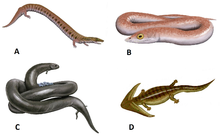Lepospondyl
| Lepospondyls Temporal range: 350–251 Ma Early Carboniferous - Late PermianPossible descendant taxon Lissamphibia survives to present |
|
|---|---|
 |
|
| Lepospondyli diversity. (Rhynchonkos (A), Phlegethontia (B), Lysorophus (C) & Diplocaulus (D)) | |
| Scientific classification | |
| Kingdom: | Animalia |
| Phylum: | Chordata |
| Clade: | Reptiliomorpha |
| Subclass: |
†Lepospondyli Zittel, 1888 |
| Groups | |
|
†Adelospondyli |
|
†Adelospondyli
†Aïstopoda
†Lysorophia
†"Microsauria"
†"Nectridea"
Lepospondyli is a diverse taxon of batrachomorphs. With the exception of one late-surviving lepospondyl from the Late Permian of Morocco (Diplocaulus minumus), lepospondyls lived from the Early Carboniferous (Mississippian) to the Early Permian and were geographically restricted to what is now Europe and North America. Five major groups of lepospondyls are known: Adelospondyli; Aïstopoda; Lysorophia; Microsauria; and Nectridea. Lepospondyls have a diverse range of body forms and include species with newt-like, eel- or snake-like, and lizard-like forms. Various species were aquatic, semiaquatic, or terrestrial. None were large (the biggest genus, the diplocaulid Diplocaulus, reached a meter in length, but most were much smaller), and they are assumed to have lived in specialized ecological niches not taken by the more numerous temnospondyl amphibians that coexisted with them in the Paleozoic. Lepospondyli was named in 1888 by Karl Alfred von Zittel, who coined the name to include some tetrapods from the Paleozoic, that shared some specific characteristics in the and teeth.
...
Wikipedia
